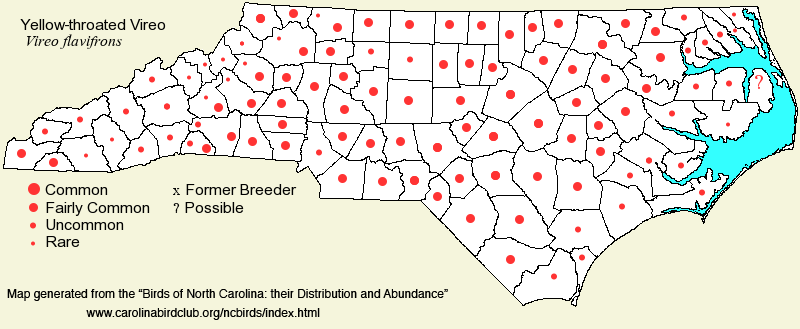 |  |
|
Yellow-throated Vireo - Vireo flavifrons VIREONIDAE Members: | Search Common: Search Scientific: |
|
|
|||||||
| General Comments | The Yellow-throated Vireo has a breeding range that closely matches the "eastern deciduous forest" biome. As with most migratory songbirds, it winters south of the United States, though there are a few reports in winter in North Carolina (most if not all likely to have been Pine Warblers), none of which have been confirmed with photos. It nests over most of the state, but is absent or scarce in the eastern Coastal Plain and in the higher mountains. It favors mature forests or groves, either wholly deciduous or at least mostly so (it tends to avoid pines), and has a slight preference for bottomlands or wooded streamsides (as opposed to swamps or to drier sites). This is a sluggish bird, usually remaining well up in the canopy, not moving much, often requiring patience to see well. | ||||||
| Breeding Status | Breeder | ||||||
| NC BRC List | Definitive | ||||||
| State Status | |||||||
| U.S. Status | |||||||
| State Rank | S4B | ||||||
| Global Rank | G5 | ||||||
| Coastal Plain | Summer resident. Fairly common over the western and central portions, but rare to locally absent farther eastward such as in the Dismal Swamp area, most of the Pamlimarle Peninsula, most of Croatan National Forest, and the Green Swamp. It is absent as a breeder along the coast, as well. Mainly early Apr to late Sep. One was photographed on the late date of 18 Nov 2023 in Buxton Woods (Dare). Apparently just one winter report, one photographed at Buxton Woods on 10 Dec 2022. Peak counts: (of migrants), 11 at Corolla (Currituck), 3 Oct 2004. | ||||||
| Piedmont | Summer resident. Fairly common over most of the province, though likely slightly less numerous in the foothills. Mainly early Apr to late Sep. Two Dec reports, neither documented by photos. Peak counts: | ||||||
| Mountains | Summer resident. Generally uncommon (to perhaps locally fairly common) in the lower elevations (to about 3,000 feet); mostly occurs in streamside groves along rivers and creeks, as opposed to forests. Essentially absent above about 3,500 feet. No winter reports. Mainly early Apr to late Sep. Peak counts: | ||||||
| Finding Tips |
Usually a few can be found in a morning of birding in the Coastal Plain and Piedmont, such as in a state park. *** | ||||||
| Attribution | LeGrand[2024-02-10], LeGrand[2023-05-19], LeGrand[2023-03-24] | ||||||
| NC Map Map depicts all counties with a report (transient or resident) for the species. | Click on county for list of all known species. |
| NC Breeding Season Map Map depicts assumed breeding season abundance for the species. |  |